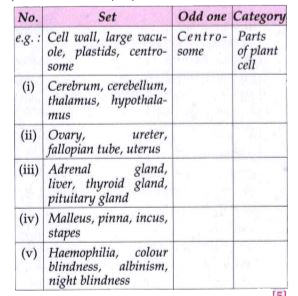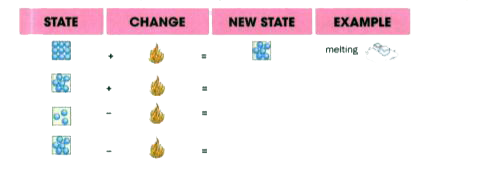Given below are six sets with four terms each. In each set a term is an odd one and cannot be grouped in the same category to which the other three belong. Identify the odd one in each set and name the category to which the remaining three belong. The first one has been done as an example:
Example : Fructose, Sucrose, Glucose, Calcium.
Odd term : Calcium
Category : Carbohydrates.
Carbonic acid, acetic acid, benzoic acid, boric acid.
To solve the problem, we need to analyze the given set of terms and identify the odd one out, along with the category for the remaining terms. Let's break down the solution step by step.
1. Identify the Terms: The terms given are carbonic acid, acetic acid, benzoic acid, and boric acid.
2. Analyze Each Term:
- Carbonic Acid: A weak acid formed when carbon dioxide is dissolved in water.
- Acetic Acid: A weak acid that is the main component of vinegar.
- Benzoic Acid: A simple aromatic carboxylic acid used as a food preservative.
- Boric Acid: A weak acid often used as an antiseptic and insecticide.
3. Determine the Common Category:
- Carbonic acid, benzoic acid, and boric acid are primarily known for their roles in various chemical and biological processes, including antiseptic properties.
- Acetic acid, on the other hand, is primarily known for its use as a preservative in food.
4. Identify the Odd One Out:
- The odd one in this set is Acetic Acid because it is primarily used as a food preservative, while the other three acids are more commonly associated with antiseptic properties.
5. Name the Category:
- The category for the remaining three terms (carbonic acid, benzoic acid, boric acid) is Antiseptics.
Final Answer:
- Odd Term: Acetic Acid
- Category: Antiseptics
- Carbonic Acid: A weak acid formed when carbon dioxide is dissolved in water.
- Acetic Acid: A weak acid that is the main component of vinegar.
- Benzoic Acid: A simple aromatic carboxylic acid used as a food preservative.
- Boric Acid: A weak acid often used as an antiseptic and insecticide.
- Carbonic acid, benzoic acid, and boric acid are primarily known for their roles in various chemical and biological processes, including antiseptic properties.
- Acetic acid, on the other hand, is primarily known for its use as a preservative in food.
- The odd one in this set is Acetic Acid because it is primarily used as a food preservative, while the other three acids are more commonly associated with antiseptic properties.
- The category for the remaining three terms (carbonic acid, benzoic acid, boric acid) is Antiseptics.
- Odd Term: Acetic Acid
- Category: Antiseptics
Topper's Solved these Questions
- SAMPLE PAPER 2013BOOK - ICSECHAPTER - SAMPLE PAPER 2013EXERCISE - SECTION-I (CHOOSE THE CORRECT ANSWER)
5 Videos
- SAMPLE PAPER 2013BOOK - ICSECHAPTER - SAMPLE PAPER 2013EXERCISE - SECTION-II
56 Videos
- SAMPLE PAPER 2012BOOK - ICSECHAPTER - SAMPLE PAPER 2012EXERCISE - SECTION-II
57 Videos
- SAMPLE PAPER 2014BOOK - ICSECHAPTER - SAMPLE PAPER 2014EXERCISE - SECTION-II
72 Videos
Similar Questions
Given below are six sets with four terms each. In each set a term is an odd one and cannot be grouped in the same category to which the other three belong. Identify the odd one in each set and name the category to which the remaining three belong. The first has been done for you as an example.

View SolutionGiven below are six sets with four terms each. In each set a term is an odd one and cannot be grouped in the same category to which the other three belong. Identify the odd one in each set and name the category to which the remaining three belong. The first one has been done as an example:
Example : Fructose, Sucrose, Glucose, Calcium.
Odd term : Calcium
Category : Carbohydrates.
Sneezing, coughing, blinking, typing.
View SolutionGiven below is a set with four terms. In each set a term is an odd one and cannot be grouped in the same category to which the other three belong. Identify the odd one in each set and name the category to which the remaining three belong. The first one has been done as an example:
Example : Fructose, Sucrose, Glucose, Calcium.
Odd term : Calcium
Category : Carbohydrates.
Saliva, bile, sweat, tears.
View SolutionGiven below are six sets with four terms each. In each set a term is an odd one and cannot be grouped in the same category to which the other three belong. Identify the odd one in each set and name the category to which the remaining three belong. The first one has been done as an example:
Example : Fructose, Sucrose, Glucose, Calcium.
Odd term : Calcium
Category : Carbohydrates.
Cretinism, myxedema, simple goitre, acromegaly.
View SolutionGiven below are six sets with four terms each. In each set one term is odd and cannot be grouped in the same category to which the other three belong. Identify the odd one in each set and name the category to which the remaining three belong. The first one has been done as an example.
Example: Calyx, Corolla, Stamens, Midrib
Odd term : Midrib
Category : Parts of a flower.
Haemoglobin, Glucagon, lodopsin, Rhodopsin.
View SolutionGiven below are six sets with four terms each. In each set one term is odd and cannot be grouped in the same category to which the other three belong. Identify the odd one in each set and name the category to which the remaining three belong. The first one has been done as an example.
Example: Calyx, Corolla, Stamens, Midrib
Odd term : Midrib
Category : Parts of a flower.
Oxytocin, Insulin, Prolactin, Progesterone.
View SolutionGiven below are six sets with four terms each. In each set one term is odd and cannot be grouped in the same category to which the other three belong. Identify the odd one in each set and name the category to which the remaining three belong. The first one has been done as an example.
Example: Calyx, Corolla, Stamens, Midrib
Odd term : Midrib
Category : Parts of a flower.
Transpiration, Photosynthesis, Phagocytosis, Guttation.
View SolutionIdentify the odd one in each set and name the category to which the remaining three belong :
Semicircular canals, Cochlea, Tympanum, Utriculus.
View SolutionIdentify the odd one in each set and name the category to which the remaining three belong :
Aqueous humour, Vitreous humour, Iris, Central canal
View SolutionComplete the table given below . (The first one has been done as an example )

View Solution
